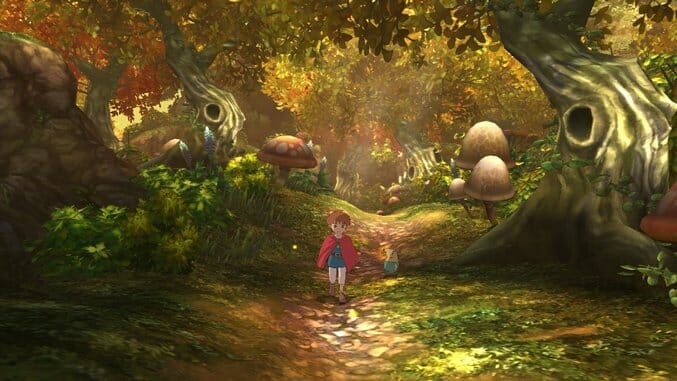Ni No Kuni: Wrath of the White Witch (PlayStation 3)

Like The Chronicles of Narnia and Peter Pan, Ni No Kuni promises a romping adventure through far-away, cotton-candy lands, but with a snail-like pace, punishing difficulty and baffling design decisions it creates more frustration than anything else. That’s not to say those things you’ve heard aren’t true: step through the wardrobe and you’ll find a beautiful game, with weird, awe-inspiring character and environment design from the conjurers at Studio Ghibli (Spirited Away, Princess Mononoke). Visually, this is a game with few equals. Plus, the British-accent-heavy voice acting is a joy, paired with a soaring Studio Ghibli score that’s perhaps the most adventurous feeling thing in the game. A simple plot ties the action together, and manages to carry enough weight to tug at your heartstrings and make you feel like a kid again.
You play as a young boy named Oliver, who lives in the idyllic American town of Motorville, circa 1950. Early on his mom dies in a freak accident, sacrificing herself for Oliver’s sake. That night, one of his tears drops on a stuffed animal—a gift from his mother—which magically comes to life. The doll, whose name is Drippy, informs Oliver (in a ridiculously endearing Welsh accent) that his home world is in trouble, assailed by evil, and Oliver is the only one capable of helping—and that he might be able to get his mother back in the process. Naturally, they are soon whisked away to this other world.
Oliver, it turns out, is a wizard. In the world of Ni No Kuni, wizards keep themselves out of the fray by employing the use of familiars—beasts which they tame and employ as combatants. A large component of the game is capturing, training and empowering your familiars. Most every enemy you fight is able to be captured and put to use in battle. They level up, gain abilities and evolve into stronger forms—giving the player an impressive amount of “characters” to choose from. That variety is expanded by branching evolutionary paths for each familiar, making for a system that you can easily get lost in.
All that sounds like the stuff that adventure is made of, tinged with Neverland and Mr. Tumnus and the like, but the game employs a slow pace that keeps it from really feeling like the downhill adventure you want it to be. This central conflict of interest infects the whole game, making you constantly wish that things would speed up more—but it never does. Yes, the world is beautiful and filled with wonder, but you slog through it so slowly that it too often feels like a chore, and unlike the fun child-quests that the game uses as inspiration.
This isn’t helped by a number of strange design decisions, which make things take longer and feel harder than is necessary. The game routinely asks you to cast spells outside of combat as you walk around the world. This is fine, and deserves credit for actually even acknowledging that characters can use magic outside of battle, but it’s detrimental given the frequency of such interactions. There is only one spell to fit any situation, and it’s usually clearly spelled out to you by the game. You just open a menu and cast it, without even an accompanying animation for payoff. This is the audio-visual equivalent of matching shapes to each other—a useless exercise that bogs the game down, with no real reward other than jumping through the hoop and moving on. The game’s also slow to add conveniences, with basic travel options—boat, fast travel, flight—being added long after you would like to have them. And even though the voice acting is largely good, it’s sparse that the game occasionally feel lifeless, especially with the lack of music that often accompanies lengthy, text-only conversations.
But one decision Ni No Kuni absolutely nails is the inclusion of an old-school overworld map. Done in the beautiful, rich art treatment found throughout the rest of the game, the map works to make the world feel large and connected, avoiding the set-piece-ism of many modern JRPGs. However, the encounter rate on the overworld is maddeningly high. Adventure, once again, is bogged down too heavily to feel right.
Central to the game is the combat system. You control one party member (and by extension familiar, which each ally can deploy only one of at a time), with the others acting off tactics you set for them. Battles happen in real-time: You select ‘Attack,’ and for the next couple of seconds your character will attack until it’s time for a new command. You’re free to move around, which has limited use beyond running away from enemies and picking up restorative drops that appear around the battlefield. Pressing L1 at any time allows you to cycle through the party member you’re controlling. It will take new players a few deaths to learn that switching between who you’re controlling in battle is the lynchpin to success. You’ve got to do it a lot, keeping in mind the circumstances you’re currently in. Do you need a tank? Someone that can evade? Should you use a ranged or melee attacker? These are life-and-death, succeed-or-fail decisions.
-

-

-

-

-

-

-

-

-

-

-

-

-

-

-

-

-

-

-

-

-

-

-

-

-

-

-

-

-

-

-

-

-

-

-

-

-

-

-

-









































